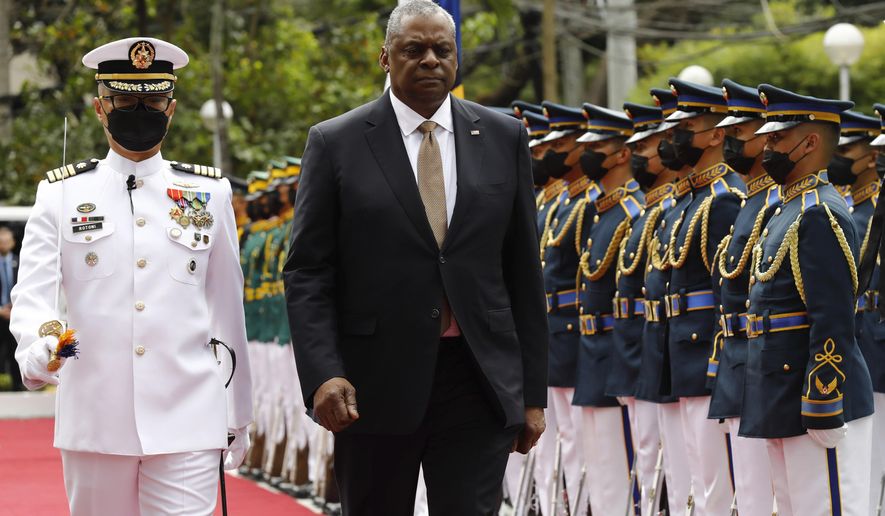The Pentagon extended its strategic reach across the Indo-Pacific region Thursday in its mounting competition with China, after the Philippines agreed to offer four new sites for the use of U.S. forces.
The announcement, the highlight of a two-day visit by Defense Secretary Lloyd Austin, nearly doubles the number of sites available for U.S. forces and should enhance Washington’s power-projection capabilities over nearby flash points.
“America’s commitment to the defense of the Philippines is iron-clad,” Mr. Austin told a press conference. “Our alliance helps … uphold a free and open Indo-Pacific.”
The partnership ensures that “no inch of our territory will be lost,” said Philippine Defense Secretary Carlito Galvez.
While Washington strategizes on how to deter a Chinese military move against nearby Taiwan, Manila fears Beijing’s ongoing expansion into nearby island chains, as well as Chinese fishing fleets’ encroachment into its territorial waters.
But the Austin visit left a number of questions still hanging, including the location of the four new sites, when they will be available for American forces, and how much investment will be made in the long-troubled bilateral Enhanced Defense Cooperation Agreement.
A question of commitment
After huge, permanent U.S. bases in the Philippines closed in the early 1990s, the EDCA was signed in 2014. The accord called initially for five physical locations where the U.S. could store equipment and rotate troops and assets in and out — while not calling for a permanent basing. In reality, critics say, the agreement has fallen far short of expectations.
Unlike U.S. bases in economic powerhouses Japan and South Korea, the EDCA sites have been hampered by local underinvestment, while Washington’s contribution also looks paltry: The Pentagon’s own figures show that the U.S. government has allocated just “over $82 million toward infrastructure investments at the existing five sites.”
The agreement was also put on the back burner by the administration of previous President Rodrigo Duterte, which pivoted away from the U.S. and toward China, before President Ferdinand Marcos Jr. took power in 2022.
Now, the program may get a boost.
“President Marcos has approved four new EDCA locations,” Mr. Austin said Thursday. “That brings the total EDCA sites to nine.”
But the Pentagon news release also noted in passing plans to “accelerate” the full implementation of EDCA, including “the substantial completion of the projects in the existing five agreed locations.” Not only are the first five sites incomplete almost a decade after the accord was signed, Mr. Galvez refused to say where the four new sites are.
Consultations must first be held with local communities before locations can be revealed, he explained.
As for when they might become operable, he said, “soon,” while adding of the four new locations, “We have to remove the word ‘bases.’… We call them ‘EDCA sites.’”
There has been speculation that the new EDCA locations will be in northern Luzon, well placed for operations south of Taiwan, and in Palawan, east of the disputed Spratly Islands — one of many sites in the region where China’s territorial claims clash with those of its neighbors.
China has the means to enforce its maritime ambitions. Its fleet is far mightier than that of any Southeast Asian nation, and even outnumbers the U.S. Navy. This makes it critical for U.S. forces to be able to operate from allies such as the Philippines.
“If this goes as planned, the Americans will have the ability to disperse their [regional] forces far more than is currently the case,” said Grant Newsham, a retired U.S. Marine officer and ex-diplomat. “This is an advantage in terms of survivability, but also it allows many more offensive options for U.S. forces.”
That is particularly so in the Luzon Strait, between the Philippines and Taiwan.
But like other U.S. allies in the region, the Philippines remains economically linked at the hip to China, its leading trade partner. Indeed, Mr. Marcos made a three-day visit to China in January, meeting President Xi Jinping.
These factors may explain the caution implicit in Thursday’s announcements.
“I think there are diplomatic nuances and concerns about having U.S. boots on the ground — permanently or rotating,” said Alex Neill, a security expert and fellow at think tank the Pacific Forum.
“Though with the new administration in Manila, there seems to have been quite a sea change compared to the Duterte administration.”
• Andrew Salmon can be reached at asalmon@washingtontimes.com.




Please read our comment policy before commenting.